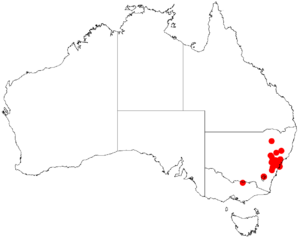Lunate-leaved acacia facts for kids
Quick facts for kids Lunate-leaved acacia |
|
|---|---|
| Scientific classification | |
| Genus: |
Acacia
|
| Species: |
lunata
|
 |
|
| Where the Lunate-leaved acacia grows in Australia | |
The Lunate-leaved acacia is a type of shrub. Its scientific name is Acacia lunata. This plant is part of the Acacia family. It is a special plant that grows only in eastern Australia.
Contents
What the Lunate-leaved Acacia Looks Like
This shrub usually grows to be about 1 to 3 meters (3 to 10 feet) tall. It tends to spread out wide. Its branches are smooth, meaning they have no hairs.
The plant has special leaf-like parts called phyllodes. These phyllodes are shaped like a crescent moon or a narrow oval.
Flowers and Seed Pods
The Lunate-leaved acacia produces many flowers. These flowers grow in clusters called inflorescences. They are found in the upper parts of the branches.
Each flower cluster is shaped like a ball. These flower balls are about 5 to 6 millimeters (0.2 to 0.24 inches) wide. They contain three to five bright golden flowers packed together.
After the flowers, the plant grows seed pods. These pods are firm but thin. They are long and narrow, growing up to 6 centimeters (2.4 inches) long. They are about 7 to 8 millimeters (0.28 to 0.31 inches) wide.
Inside the pods are dull black seeds. The seeds are oval-shaped and about 4 millimeters (0.16 inches) long. They are lined up inside the pod.
How the Lunate-leaved Acacia Was Named
The Lunate-leaved acacia was first officially described in 1819. A botanist named Conrad Loddiges gave it its scientific name. He wrote about it in a book called The Botanical Cabinet.
Later, in 2003, another botanist named Leslie Pedley changed its name to Racosperma lunatum. But then, in 2006, it was changed back to its original name, Acacia lunata.
Where the Lunate-leaved Acacia Grows
This plant naturally grows in a specific part of New South Wales, Australia. You can find it from around Cessnock in the north. It grows southwards to areas near Richmond.
It prefers to grow on slopes and near creeks. The soil it likes is sandy and based on sandstone. The Lunate-leaved acacia is often found in open forests where Eucalyptus trees grow.

